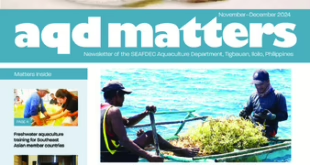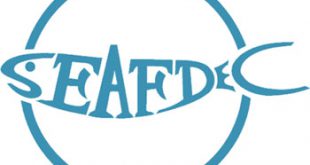 Research at SEAFDEC Aquaculture Department (AQD) aims to develop and refine science-based aquaculture technologies, and strengthen responsible aquaculture in Southeast Asia.
Research at SEAFDEC Aquaculture Department (AQD) aims to develop and refine science-based aquaculture technologies, and strengthen responsible aquaculture in Southeast Asia.
To uphold this goal, AQD welcomes research collaboration with academic and R&D institutions, non-government organizations, private sector, and government agencies in SEAFDEC member countries and other parts of the world. Proposals maybe submitted, assessed, and approved at anytime within the year.
Number of papers published by AQD researchers from 1976 to September 2008
Sample research topics of students/institutions who collaborated with AQD
Research priorities
Proposals are usually in areas that AQD consider as priorities. However, collaborators may work on their own areas of interest.
At present, the following economically important commodities are under study at AQD:
• mollusks (abalone, top shell, giant clam, oyster-mussel)
• crustaceans (mudcrab, tiger shrimp, white shrimps, giant freshwater prawn)
• fishes (grouper, milkfish, tilapia, bighead carp, catfish, seabass, snapper, siganids)
• seaweeds (Gracilaria, Kappaphycus)
• diatoms/microalgae
Collaboration may be on the various life stages of the above species (broodstock, hatchery, nursery, grow-out).
If the interest is on biotechnology, AQD has a well-equipped Laboratory for advanced aquaculture technologies and enclosed wet laboratories for the isolated confinement of hormone-treated or genetically manipulated commodities.
Studies that can be conducted at the biotechnology laboratories include:
• molecular microbiology (rapid disease detection and diagnosis)
• molecular endocrinology and genetics (growth enhancement and genetic characterization of wild stocks)
• algal production (strain improvement in seaweeds and high density production of algae used as food for fish, crustacean, and mollusk larvae)
• fish feed technology (nutrient enhancement and development of low-polluting diets)
Why collaborate with us?
• We have the facilities to do studies in tanks, ponds, and cages. We also have state-of-the-art biotechnology laboratories.
• We have multidisciplinary teams, and we have the track record for research (see table).
Number of papers published by AQD researchers from 1976 to September 2008
| Commodity | ISI-CC covered science journals | Other science journals | Proceedings/books |
| Abalone | 14 | 2 | 4 |
| Bighead carp | 11 | 5 | 13 |
| Catfish | 18 | 3 | 10 |
| Freshwater prawn | 1 | – | 3 |
| Grouper | 29 | 9 | 37 |
| Milkfish | 121 | 40 | 48 |
| Mudcrab | 26 | 14 | 13 |
| Mollusks (other than abalone) | 15 | 7 | 12 |
| Seabass | 42 | 7 | 19 |
| Seaweeds | 33 | 13 | 12 |
| Siganids | 25 | 5 | 14 |
| Snapper | 11 | 1 | 11 |
| Tiger shrimp | 141 | 58 | 85 |
| Tilapia | 42 | 15 | 27 |
| Discipline | |||
| Fish health | 93 | 21 | 85 |
| Larval food, feed development and fish nutrition | 191 | 43 | 95 |
| Stock enhancement | 4 | 1 | 4 |
| Mangroves, aquatic ecology and environment | 71 | 22 | 59 |
| Socioeconomics and coastal fisheries resources management | 26 | 21 | 25 |
| Others | 31 | 10 | 37 |
Note: Some papers are cross-cited in several commodities though the total number of AQD’s published papers since 1976 to September 2008 is 1,263
ISI-CC is Institute of Scientific Information’s Current Contents
AQD research facilities

Flow chart for proposals
Sample research topics of students/institutions who collaborated with AQD:

 • Comparison of the growth performance and survival of giant freshwater prawn in cages fed with natural food or commercially formulated feeds (Hohenheim University, Stuttgart, Germany, 2008)
• Comparison of the growth performance and survival of giant freshwater prawn in cages fed with natural food or commercially formulated feeds (Hohenheim University, Stuttgart, Germany, 2008)
• Comparison of characteristics of KHV isolates from Asia (Fisheries Research Agency, Japan, 2004)
• Insulin-like growth factor II (IGF-II) as molecular markers for egg quality in finfish and mudcrab (Australian Center for International Agricultural Research, 2004)
• Development of release strategies for stock enhancement of the tropical abalone Haliotis asinina (International Foundation Science, 2003)
• Improvement of growth and survival in cultured rabbitfish (Siganus guttatus) (United States AID, 2000)

 • Development of bio-encapsulated feed for larval fish based on nutritionally enriched nematodes:free-living nematodes as feed for bighead carp larvae (European Union, 1998)
• Development of bio-encapsulated feed for larval fish based on nutritionally enriched nematodes:free-living nematodes as feed for bighead carp larvae (European Union, 1998)
• Influence of some environmental factors on growth rate and agar quality of selected Gracilaria species found in Iloilo (University of the Philippines Diliman, 1993)
• Methionine requirement of milkfish (Chanos chanos Forsskal) juveniles (University of the Philippines Visayas, 1990)
 SEAFDEC/AQD Southeast Asian Fisheries Development Center | Aquaculture Department
SEAFDEC/AQD Southeast Asian Fisheries Development Center | Aquaculture Department






